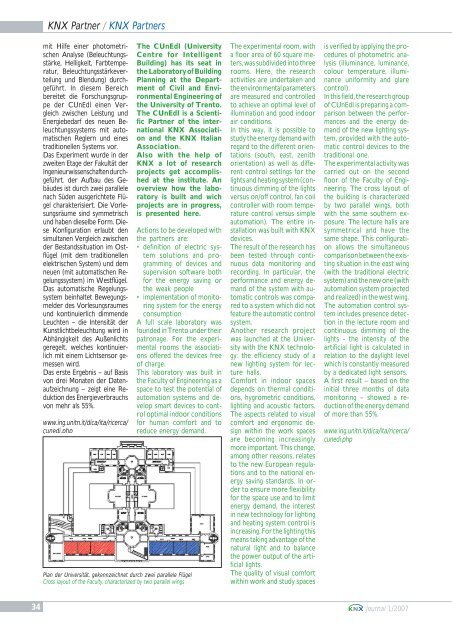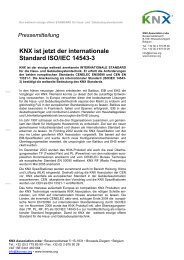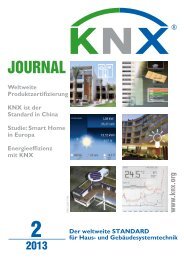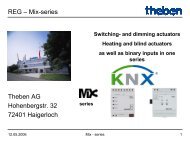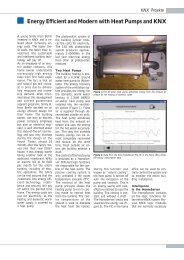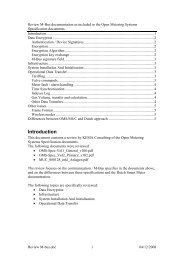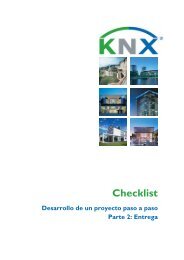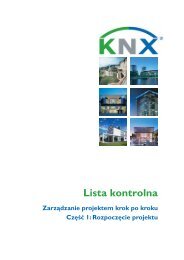JOURNAL - KNX
JOURNAL - KNX
JOURNAL - KNX
Sie wollen auch ein ePaper? Erhöhen Sie die Reichweite Ihrer Titel.
YUMPU macht aus Druck-PDFs automatisch weboptimierte ePaper, die Google liebt.
<strong>KNX</strong> Partner / <strong>KNX</strong> Partners<br />
mit Hilfe einer photometrischen<br />
Analyse (Beleuchtungsstärke,<br />
Helligkeit, Farbtemperatur,<br />
Beleuchtungsstärkeverteilung<br />
und Blendung) durchgeführt.<br />
In diesem Bereich<br />
bereitet die Forschungsgruppe<br />
der CUnEdl einen Vergleich<br />
zwischen Leistung und<br />
Energiebedarf des neuen Beleuchtungssystems<br />
mit automatischen<br />
Reglern und eines<br />
traditionellen Systems vor.<br />
Das Experiment wurde in der<br />
zweiten Etage der Fakultät der<br />
Ingenieurwissenschaften durchgeführt.<br />
der Aufbau des Gebäudes<br />
ist durch zwei parallele<br />
nach Süden ausgerichtete Flügel<br />
charakterisiert. Die Vorlesungsräume<br />
sind symmetrisch<br />
und haben dieselbe Form. Diese<br />
Konfiguration erlaubt den<br />
simultanen Vergleich zwischen<br />
der Bestandssituation im Ostflügel<br />
(mit dem traditionellen<br />
elektrischen System) und dem<br />
neuen (mit automatischen Regelungssystem)<br />
im Westflügel.<br />
Das automatische Regelungssystem<br />
beinhaltet Bewegungsmelder<br />
des Vorlesungsraumes<br />
und kontinuierlich dimmende<br />
Leuchten – die Intensität der<br />
Kunstlichtbeleuchtung wird in<br />
Abhängigkeit des Außenlichts<br />
geregelt, welches kontinuierlich<br />
mit einem Lichtsensor gemessen<br />
wird.<br />
Das erste Ergebnis – auf Basis<br />
von drei Monaten der Datenaufzeichnung<br />
– zeigt eine Reduktion<br />
des Energieverbrauchs<br />
von mehr als 55%.<br />
www.ing.unitn.it/dica/ita/ricerca/<br />
cunedi.php<br />
The CUnEdI (University<br />
Centre for Intelligent<br />
Building) has its seat in<br />
the Laboratory of Building<br />
Planning at the Department<br />
of Civil and Environmental<br />
Engineering of<br />
the University of Trento.<br />
The CUnEdI is a Scientific<br />
Partner of the international<br />
<strong>KNX</strong> Association<br />
and the <strong>KNX</strong> Italian<br />
Association.<br />
Also with the help of<br />
<strong>KNX</strong> a lot of research<br />
projects get accomplished<br />
at the institute. An<br />
overview how the laboratory<br />
is built and wich<br />
projects are in progress,<br />
is presented here.<br />
Actions to be developed with<br />
the partners are:<br />
• definition of electric system<br />
solutions and programming<br />
of devices and<br />
supervision software both<br />
for the energy saving or<br />
the weak people<br />
• implementation of monitoring<br />
system for the energy<br />
consumption<br />
A full scale laboratory was<br />
founded in Trento under their<br />
patronage. For the experimental<br />
rooms the associations<br />
offered the devices free<br />
of charge.<br />
This laboratory was built in<br />
the Faculty of Engineering as a<br />
space to test the potential of<br />
automation systems and develop<br />
smart devices to control<br />
optimal indoor conditions<br />
for human comfort and to<br />
reduce energy demand.<br />
Plan der Universität, gekennzeichnet durch zwei parallele Flügel<br />
Cross layout of the Faculty, characterized by two parallel wings<br />
The experimental room, with<br />
a floor area of 60 square meters,<br />
was subdivided into three<br />
rooms. Here, the research<br />
activities are undertaken and<br />
the environmental parameters<br />
are measured and controlled<br />
to achieve an optimal level of<br />
illumination and good indoor<br />
air conditions.<br />
In this way, it is possible to<br />
study the energy demand with<br />
regard to the different orientations<br />
(south, east, zenith<br />
orientation) as well as different<br />
control settings for the<br />
lights and heating system (continuous<br />
dimming of the lights<br />
versus on/off control, fan coil<br />
controller with room temperature<br />
control versus simple<br />
automation). The entire installation<br />
was built with <strong>KNX</strong><br />
devices.<br />
The result of the research has<br />
been tested through continuous<br />
data monitoring and<br />
recording. In particular, the<br />
performance and energy demand<br />
of the system with automatic<br />
controls was compared<br />
to a system which did not<br />
feature the automatic control<br />
system.<br />
Another research project<br />
was launched at the University<br />
with the <strong>KNX</strong> technology:<br />
the efficiency study of a<br />
new lighting system for lecture<br />
halls.<br />
Comfort in indoor spaces<br />
depends on thermal conditions,<br />
hygrometric conditions,<br />
lighting and acoustic factors.<br />
The aspects related to visual<br />
comfort and ergonomic design<br />
within the work spaces<br />
are becoming increasingly<br />
more important. This change,<br />
among other reasons, relates<br />
to the new European regulations<br />
and to the national energy<br />
saving standards. In order<br />
to ensure more flexibility<br />
for the space use and to limit<br />
energy demand, the interest<br />
in new technology for lighting<br />
and heating system control is<br />
increasing. For the lighting this<br />
means taking advantage of the<br />
natural light and to balance<br />
the power output of the artificial<br />
lights.<br />
The quality of visual comfort<br />
within work and study spaces<br />
is verified by applying the procedures<br />
of photometric analysis<br />
(illuminance, luminance,<br />
colour temperature, illuminance<br />
uniformity and glare<br />
control).<br />
In this field, the research group<br />
of CUnEdI is preparing a comparison<br />
between the performances<br />
and the energy demand<br />
of the new lighting system,<br />
provided with the automatic<br />
control devices to the<br />
traditional one.<br />
The experimental activity was<br />
carried out on the second<br />
floor of the Faculty of Engineering.<br />
The cross layout of<br />
the building is characterized<br />
by two parallel wings, both<br />
with the same southern exposure.<br />
The lecture halls are<br />
symmetrical and have the<br />
same shape. This configuration<br />
allows the simultaneous<br />
comparison between the existing<br />
situation in the east wing<br />
(with the traditional electric<br />
system) and the new one (with<br />
automation system projected<br />
and realized) in the west wing.<br />
The automation control system<br />
includes presence detection<br />
in the lecture room and<br />
continuous dimming of the<br />
lights - the intensity of the<br />
artificial light is calculated in<br />
relation to the daylight level<br />
which is constantly measured<br />
by a dedicated light sensors.<br />
A first result – based on the<br />
initial three months of data<br />
monitoring – showed a reduction<br />
of the energy demand<br />
of more than 55%.<br />
www.ing.unitn.it/dica/ita/ricerca/<br />
cunedi.php<br />
34 Journal 1/2007


